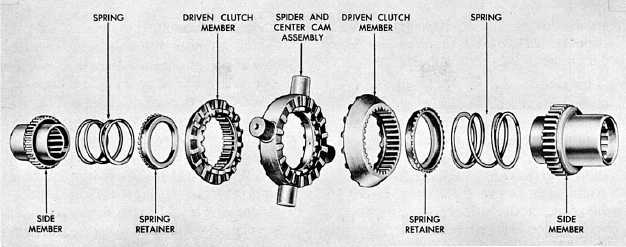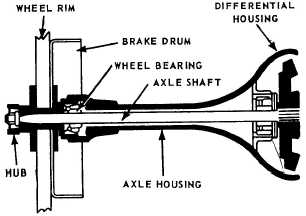Figure 13-20.—No spin differential—exploded view.
governed by the speed of the wheel applying
tractive effort.
The no-spin differential does not contain pinion
gears and side gears as does the conventional
differential. Instead, it consists basically of a
spider attached to the differential drive ring gear
through four trunnions. It also has two driven
clutch members with side teeth that are indexed
by spring pressure with side teeth in the spider.
Two side members are splined to the wheel axles
and, in turn, are splined into the driven clutch
members.
AXLES
A live axle is one that supports part of the
weight of a vehicle and drives the wheels
connected to it. A dead axle is one that carries part
of the weight of a vehicle but does not drive the
wheels. The wheels rotate on the ends of the dead
axle.
Usually, the front axle of a passenger car is a
dead axle and the rear axle is a live axle. In four-
wheel drive vehicles, both front and rear axles are
live axles; in six-wheel drive vehicles, all three
axles are live axles. The third axle, part of a bogie
drive, is joined to the rearmost axle by a trunnion
axle. The trunnion axle attaches rigidly to the
frame. Its purpose is to help distribute the load on
the rear of the vehicle to the two live axles that it
connects.
Four types of live axles are used in automotive
and construction equipment. They are: plain,
semifloating, three-quarter floating, and full
floating.
The plain live, or nonfloating, rear axle, is
seldom used in equipment today. The axle shafts
in this assembly are called nonfloating because
they are supported directly in bearings located in
the center and ends of the axle housing. In
addition to turning the wheels, these shafts carry
the entire load of the vehicle on their outer ends.
Plain axles also support the weight of the
differential case.
The semifloating axle (fig. 13-21) used on most
passenger cars and light trucks has its differential
case independently supported. The differential
carrier relieves the axle shafts from the weight of
the differential assembly and the stresses caused
by its operation. For this reason the inner ends of
the axle shafts are said to be floating. The wheels
are keyed to outer ends of axle shafts and the
outer bearings are between the shafts and the
housing. The axle shafts therefore must take the
stresses caused by turning, skidding, or wobbling
of the wheels. The axle shaft is a semifloating live
axle that can be removed after the wheel has been
pulled off.
Figure 13-21.—Semifloating rear axle.
13-17



